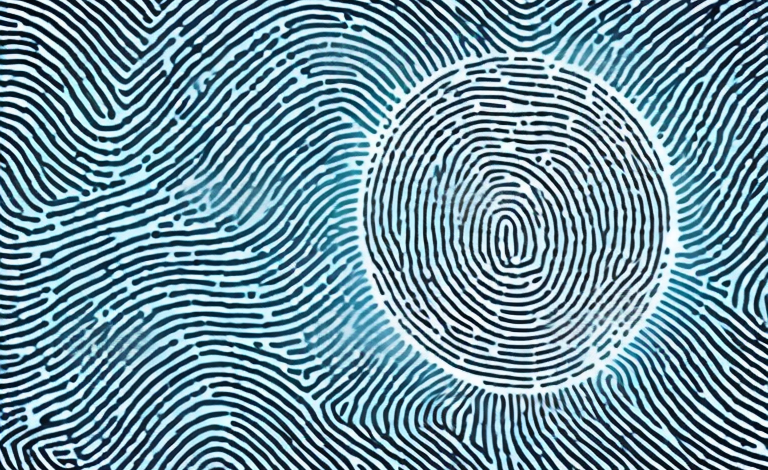In today’s increasingly digital world, security has become a major concern. With so much sensitive information being stored online, developers are always searching for ways to make certain that only the authorized user has access. One route that’s gained popularity lately is biometric authentication, utilizing fingerprints as unique identifiers. But is this method actually better than traditional passwords? In this article, we’ll examine both options to determine the advantages and disadvantages of both systems.
The Basics: Understanding Fingerprint and Password Security
Before we jump into comparing the two methods, let’s first understand what each one is all about. Passwords have been the go-to authentication system for a long time now. They are created simply by inputting one or more words or phrases that are only known to the user. These words or phrases can then be used to access a device or digital account. Biometric authentication, on the other hand, uses a physical characteristic of an individual, like fingerprints or facial recognition, as their identifier. This feature can only be possessed by that individual, making it much harder for someone to impersonate them.
However, it is important to note that biometric authentication is not foolproof. While it is much harder to replicate someone’s fingerprint or facial features, it is not impossible. Hackers have been known to use advanced techniques to create fake fingerprints or even 3D-printed replicas of faces to bypass biometric security measures. Additionally, if a person’s biometric data is compromised, it cannot be changed like a password can be. This means that if someone gains access to your fingerprint or facial recognition data, you may be at risk for a long time.
The Evolution of Authentication: From Passwords to Biometrics
Passwords have been the standard in tech security for decades. They are considered the most reliable method for keeping devices and accounts secure. However, advances in technology have shown that passwords alone may no longer be dependable. Hacking tools that leverage phishing scams and similar social engineering tactics can lure people into providing access to their accounts. Biometric authentication is an improvement to passwords that is far superior in its security features. It provides a solution to the problems that exist with passwords and renders various types of hacking and abuse irrelevant.
One of the main advantages of biometric authentication is that it is unique to each individual. Unlike passwords, which can be shared or guessed, biometric data such as fingerprints, facial recognition, and iris scans are specific to one person. This makes it much more difficult for hackers to gain access to someone’s account or device.
Another benefit of biometric authentication is its convenience. With passwords, users must remember a unique combination of letters, numbers, and symbols for each account they have. This can be difficult and time-consuming, especially if they have multiple accounts. Biometric authentication eliminates the need for passwords altogether, making it easier and faster for users to access their accounts and devices.
The Pros and Cons of Fingerprint and Password Security
While both methods have their advantages and disadvantages, it remains clear that each system is unique in its own way. Passwords involve choosing a combination of letters, numbers, or symbols to use when logging in. Passwords can be easily reused, misplaced, or forgotten, making them less secure. On the other hand, fingerprints are unique to every person and can’t be faked. The downside, however, is that if a hacker manages to copy a fingerprint, it can be used to gain unauthorized access to a device or account. Furthermore, fingerprints tend to work better when people use them to unlock their smartphones or laptops, while passwords may work better for long-term authentication.
Another advantage of fingerprint security is that it is more convenient for users. With passwords, users have to remember and type in a combination of characters every time they want to access their device or account. With fingerprint security, users simply need to place their finger on the scanner, making the process quicker and easier. Additionally, fingerprint security can be used to authenticate transactions, such as making purchases or accessing sensitive information, providing an extra layer of security.
However, there are also some limitations to fingerprint security. For example, some people may have difficulty using fingerprint scanners due to physical disabilities or injuries. Additionally, certain occupations, such as construction workers or healthcare professionals, may have fingerprints that are difficult to read due to constant wear and tear on their hands. Finally, there is also the concern of privacy, as some people may not feel comfortable with their biometric data being stored and used for authentication purposes.
How Secure Are Fingerprints?
While fingerprints may seem like the perfect solution, you might however ask, how safe are they in reality? There is no method that is completely trustworthy, and this includes fingerprint authentication. Fingerprint sensors can be easily duped by fake prints, leading to a security breach. However, this is rarely the case, as the user requires physical access to the device or system, making the task of copying the fingerprint next to impossible.
Another factor to consider is that fingerprints can be stolen or copied without the user’s knowledge. For example, a person’s fingerprint can be lifted from a surface they touched and used to gain unauthorized access to their device or system. This is why it’s important to keep your device or system secure and to regularly change your passwords.
Despite these potential risks, fingerprint authentication is still considered to be a highly secure method of authentication. It’s more secure than traditional password authentication, which can be easily hacked or guessed. As technology continues to advance, fingerprint sensors are also becoming more sophisticated and harder to fool, making them an even more reliable method of authentication.
Are Passwords Becoming Obsolete?
While biometric identification has an edge in security, passwords are still important as not all computing devices support biometric login. Passwords may not guarantee security, but their widespread use and ubiquity in technological devices cannot be ignored.
However, the use of passwords has its own set of challenges. Users often struggle to remember complex passwords, leading to the use of weak and easily guessable passwords. Additionally, passwords can be stolen or hacked, putting sensitive information at risk.
As a result, many companies are exploring alternative methods of authentication, such as multi-factor authentication and behavioral biometrics. These methods provide an additional layer of security and can help prevent unauthorized access to sensitive information.
Biometric Authentication: Advantages and Disadvantages
As aforementioned, biometric authentication is more secure. Fingerprint scanners are more reliable and harder to falsify than forgotten or stolen passwords. The downside is that biometrics require special hardware, and the efficiency of the hardware can vary among different devices. Another advantage to biometrics is that it’s relatively faster than password authentication systems, which requires typing in a password manually.
The Accuracy of Fingerprint Authentication vs Passwords
Fingerprint authentication is a lot more reliable than passwords. In order for an intruder to gain access, they would need a biometric clone of the original user’s fingerprint. This is next to impossible, effectively locking the device down. Passwords can be guessed, theft or copied, making them a less trustworthy option than biometric alternatives.
However, it is important to note that fingerprint authentication is not foolproof. Certain factors such as dirt, sweat, or cuts on the fingers can affect the accuracy of the scan. In addition, some individuals may have difficulty with fingerprint authentication due to medical conditions or disabilities. Therefore, it is important to have alternative authentication methods available for those who may not be able to use fingerprint authentication.
The Speed of Fingerprint Authentication vs Passwords
Using a fingerprint scanner is not just accurate, but it’s also quite fast. With just one touch, users can unlock their devices in a matter of seconds, which makes the login process much quicker than the traditional login method using a password.
In addition, fingerprint authentication also eliminates the need for users to remember complex passwords or to constantly reset them. This not only saves time but also reduces the risk of security breaches caused by weak passwords or password reuse. Furthermore, fingerprint authentication can also be used for secure online transactions, making it a convenient and secure alternative to traditional password-based authentication methods.
How to Choose Between Fingerprint and Password Security
When it comes down to selecting a particular authentication method, it depends on a variety of factors, including user preference and availability of compatible devices. Depending on how secure you want your device or account, if a mixture of both is feasible, go for it.
Fingerprint security is a biometric authentication method that uses unique physical characteristics to verify a user’s identity. It is considered to be more secure than traditional password authentication because it is difficult to replicate someone’s fingerprint. However, it may not be suitable for individuals with certain medical conditions or occupations that involve frequent hand injuries or exposure to chemicals that can damage fingerprints.
Password security, on the other hand, is a traditional authentication method that involves creating a unique combination of characters that only the user knows. It is widely used and compatible with most devices and systems. However, it is vulnerable to hacking and phishing attacks, and users may forget their passwords or use weak ones that are easy to guess.
The Future of Authentication: Will We See More Biometric Solutions?
With a rapidly growing tech industry, there is no telling what the future holds. Many predict that biometric authentication will further improve, with the implementation of ongoing research on various identification characteristics such as face recognition, voice recognition or even DNA. Such innovations provide a future of possibilities for the tech industry, making the authentication process even more secure.
Hackers and Biometrics: Can They Steal Your Fingerprint Data?
While cybersecurity needs remain necessary with fingerprint login systems in place, it’s still not a fail-safe security method. There is no doubt that hackers have derived new methods to try and compromise biometric identifiers such as fingerprints, DNA, and voice recognition. Despite these innovations, biometric authentication still remains the most secure way to protect your digital access.
Government Surveillance and the Use of Biometrics in Security
Government sponsored programs such as the Aadhaar project in India have made use of biometric authentication on a massive scale. While some argue that biometric data breaches, particularly targeted by Government entities, would be incredibly dangerous and extremely unethical, we cannot help but in fact rejoice and support such innovations, quickening and facilitating access to essential Government documentation.
Cost Comparison: Fingerprint Scanners vs Traditional Password Systems
Fingerprint scanners can be very costly, adding to the overall cost of a device or system. They require specialized hardware in order to function, and this means that they can be more expensive to produce than traditional keyboard-based authentication systems.
Which One Is More Convenient: Fingerprint or Password?
Despite the complexities involved with biometric authentication, the convenience and efficiency of fingerprint logins is hard to ignore. In comparison to traditional passwords, fingerprint login is a faster and more secure authentication method.
Conclusion
While password authentication has served the technology industry for a long time, it’s time to move on and stop relying on passwords alone. Biometric authentication provides a solution to the many problems that come with passwords and renders various types of cyberattacks irrelevant. In conclusion, biometric authentication is more secure and represents the future of the security industry.



